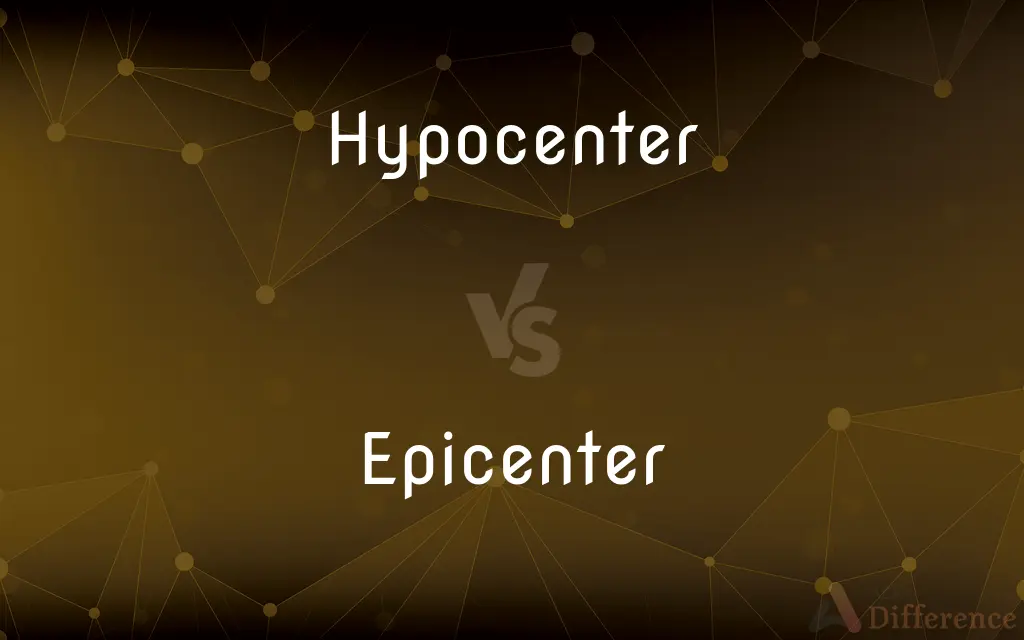Hypocenter vs. Epicenter — What's the Difference?
By Urooj Arif & Maham Liaqat — Updated on March 12, 2024
Hypocenter is the underground point of origin for an earthquake, while epicenter is directly above it on the Earth's surface.

Difference Between Hypocenter and Epicenter
Table of Contents
ADVERTISEMENT
Key Differences
The hypocenter, also known as the focus, refers to the precise underground location where the seismic energy of an earthquake originates. It is the point inside the Earth where the strain energy is first released, starting the seismic waves that propagate through the Earth's crust. On the other hand, the epicenter is the point on the Earth's surface that is directly above the hypocenter. It is often the location identified in reports and news as the center of the earthquake activity, where the effects of the earthquake are usually strongest.
While the hypocenter is located at varying depths beneath the Earth's surface, its depth can significantly influence the intensity and distribution of the earthquake's surface shaking. Deeper hypocenters tend to cause less surface damage but can affect a wider area. In contrast, earthquakes with shallow hypocenters often result in more severe shaking and damage concentrated around the epicenter.
Seismologists use the data from seismic waves to calculate the location of the hypocenter. By analyzing the arrival times of P-waves and S-waves at different seismograph stations, they can determine the earthquake's depth and origin. The epicenter is then mapped directly above this point. This information is crucial for assessing earthquake hazards, planning emergency responses, and understanding the geologic processes that cause earthquakes.
The distinction between hypocenter and epicenter is important in the field of seismology for communication and analysis purposes. While the epicenter is useful for identifying the affected area on the surface, the hypocenter provides insight into the earthquake's origin and mechanism. Both terms are essential for scientists to study earthquake patterns, predict potential impacts, and mitigate risks in earthquake-prone regions.
The relationship between the hypocenter and epicenter is fundamental to understanding earthquakes. Their locations relative to each other help in assessing the earthquake's potential effects on the surface and guide the implementation of building codes, emergency preparedness plans, and public safety measures in regions at risk for seismic activity.
ADVERTISEMENT
Comparison Chart
Definition
The point inside the Earth where an earthquake originates
The point on the Earth's surface directly above the hypocenter
Depth
Varies, can be shallow or deep
At the Earth's surface
Impact on Surface
Depth influences intensity and area affected
Location of strongest surface shaking
Importance in Seismology
Determines earthquake's origin and mechanism
Helps identify affected surface areas
Measurement
Calculated through seismic wave analysis
Mapped directly above the hypocenter
Compare with Definitions
Hypocenter
Located at varying depths inside the Earth.
Deep hypocenters are often associated with less surface damage but broader impact.
Epicenter
Surface point above the earthquake's hypocenter.
The epicenter was located near the city, leading to significant damage.
Hypocenter
Influences earthquake intensity and damage distribution.
The shallow hypocenter resulted in severe shaking around the epicenter.
Epicenter
Guides public safety measures and building codes.
Building regulations in the epicenter region were updated for earthquake resilience.
Hypocenter
Origin point of an earthquake's seismic energy.
The hypocenter of the earthquake was 10 km below the surface.
Epicenter
Identified for emergency response and hazard assessment.
Emergency services were dispatched to the epicenter area.
Hypocenter
Determined through seismic data analysis.
Seismologists calculated the hypocenter by analyzing P-waves and S-waves.
Epicenter
Determines the surface area most affected by shaking.
The epicenter area experienced the strongest ground motions and damage.
Hypocenter
Critical for understanding the earthquake mechanism.
Studying hypocenters helps seismologists predict seismic activity patterns.
Epicenter
Used in earthquake reporting and communication.
News reports focused on the epicenter's impact on the local community.
Hypocenter
A hypocenter (or hypocentre) (from Ancient Greek: ὑπόκεντρον [hypόkentron] for 'below the center') is the point of origin of an earthquake or a subsurface nuclear explosion. In seismology, it is a synonym of the focus.
Epicenter
The epicenter, epicentre () or epicentrum in seismology is the point on the Earth's surface directly above a hypocenter or focus, the point where an earthquake or an underground explosion originates.
Hypocenter
The surface position directly beneath the center of a nuclear explosion.
Epicenter
The point on the earth's surface directly above the focus of an earthquake.
Hypocenter
(US) hypocentre
Epicenter
The focal point of a usually harmful or unpleasant phenomenon or event; the center
Stood at the epicenter of the international crisis.
Epicenter
(American spelling) epicentre
Epicenter
(American spelling) epicentre
Epicenter
The point on the Earth's surface directly above the focus of an earthquake
Common Curiosities
How do scientists determine the epicenter of an earthquake?
Scientists use triangulation methods, analyzing the difference in arrival times of seismic waves at multiple seismograph stations to locate the epicenter.
Can there be multiple epicenters for a single earthquake?
No, there is only one epicenter for each earthquake, directly above the hypocenter, though aftershocks may have their own epicenters.
Does the distance between the hypocenter and epicenter affect the earthquake's strength?
Not directly; the strength is more influenced by the earthquake's magnitude and the hypocenter's depth, although deeper hypocenters typically result in less surface damage.
What is the difference between the focus and the hypocenter of an earthquake?
There is no difference; "focus" is another term for the hypocenter.
How can the knowledge of epicenters and hypocenters help in earthquake preparedness?
By mapping historical epicenters and hypocenters, scientists can identify seismic patterns, helping in the development of building codes, emergency planning, and public education.
What tools are used to measure the depth of the hypocenter?
Seismographs and seismometers measure the seismic waves, and their data is analyzed to calculate the hypocenter's depth.
Why is it important to know the location of the hypocenter?
Understanding the hypocenter helps in analyzing the earthquake's cause, depth, and potential impact, essential for hazard assessment and mitigation.
What role does the epicenter play in earthquake damage assessment?
The epicenter is a focal point for assessing damage, guiding emergency response, and evaluating the effectiveness of building structures.
Are the terms hypocenter and epicenter used for other events besides earthquakes?
These terms are specifically related to earthquakes and the study of seismology.
Is it possible to predict the location of future epicenters?
While scientists can identify potential seismic zones based on tectonic plate boundaries and past activity, predicting specific future epicenter locations remains challenging.
How does the depth of the hypocenter affect seismic wave propagation?
The depth influences the speed, direction, and type of seismic waves that reach the surface, affecting how widely and strongly the ground shakes.
Why might an earthquake with a deep hypocenter be felt over a wider area?
Deep hypocenters allow seismic waves to travel farther and spread out over a larger area, though with generally less surface intensity.
Can the epicenter of an earthquake be located in the ocean?
Yes, many earthquakes occur under the ocean, and their epicenters are mapped on the ocean floor, sometimes causing tsunamis.
How accurate are hypocenter and epicenter determinations?
Advances in seismology and technology have significantly improved accuracy, but there can still be uncertainties due to complex underground geology.
Can the location of the epicenter be moved or changed over time?
The epicenter's location remains fixed for a specific earthquake, but aftershocks and future seismic events will have their own epicenters.
Share Your Discovery

Previous Comparison
Conglomerate vs. Agglomerate
Next Comparison
Reboot vs. RestartAuthor Spotlight
Written by
Urooj ArifUrooj is a skilled content writer at Ask Difference, known for her exceptional ability to simplify complex topics into engaging and informative content. With a passion for research and a flair for clear, concise writing, she consistently delivers articles that resonate with our diverse audience.
Co-written by
Maham Liaqat












































